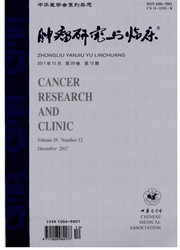

 中文摘要:
中文摘要:
目的研究恶性肿瘤患者焦虑情绪的发生情况,进一步探讨表面增强激光解吸电离飞行时间质谱(SELDI—TOF—MS,简称SELDI)技术在焦虑情绪评估中的意义。方法选取1000例恶性肿瘤患者作为研究对象,于人院当天进行焦虑自评量表(SAS)评定,次日清晨抽取患者空腹静脉血,分析比较SELDI检测结果与SAS评分结果的差异。结果有效样本为988例。SAS评分为(56.320±9.665)分,SAS评分出现焦虑情绪者454例,焦虑情绪发生率45.95%。SELDI技术检测阳性者470例,焦虑情绪发生率47.57%。以SAS评分为判断焦虑情绪的金标准,SELDI技术的灵敏度、特异度分别为93.17%、91.20%,阳性预测值、阴性预测值分别为90.00%、94.02%,总符合率为92.11%,SAS评分与SELDI丰度值相关,拟合曲线显示上调趋势,相关系数为0.837。结论恶性肿瘤患者焦虑情绪的发生率相对较高,SELDI技术在焦虑情绪的评估方面表现出较高的灵敏度、特异度、总符合率和相关性,可作为客观评估焦虑情绪的一种手段。
 英文摘要:
英文摘要:
Objective To study the occurrence of anxiety in patients with malignant tumor, and in further explore the scientificity and clinical application value of surface-enhanced laser desorption/ionization time-of-flight mass spectrometry (SELDI) technology in anxiety detection. Methods 1 000 patients with malignant tumor were selected as research objects, the self-rating anxiety scale (SAS) was used to evaluate the anxiety on the first day of admission, the fasting venous blood of patients was taken on the next day morning. The SAS score and SELDI result were compared and analyzed. Results The effective sample number was 988. The SAS score was 56.32-+ 9.665, there were 454 cases of anxiety, the incidence rate of anxiety was 45.95 %. 470 cases were SELDI test positive, and the incidence rate of anxiety was 47.57 %. SAS was used as the gold standard to judge anxiety, the sensitivity and specificity of SELDI technology were 93.17 % and 91.20 %, the positive predictive value and negative predictive value were 90.00 % and 94.02 %, the total coincidence rate was 92.11%. SAS score highly correlated with the abundance of SELDI, the fitting curve showed an up trend, and the correlation coefficient was 0.837. Conclusions The incidence of malignant tumor patients anxiety is relatively high. SELDI technique shows high sensitivity, specificity, total coincidence rate and correlation in anxiety detection, it can be used as an objective evaluation of anxiety.
 同期刊论文项目
同期刊论文项目
 同项目期刊论文
同项目期刊论文
 期刊信息
期刊信息
